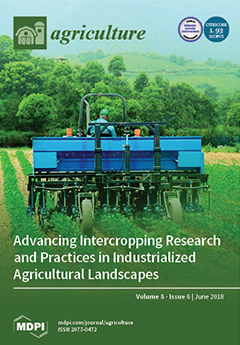A healthy crop growth ensures a good biomass development for optimal yield amounts and qualities. This can only be achieved with sufficient knowledge about field conditions. In this study we investigated the performance of optical sensors in large field trails, to predict yield and biomass characteristics. This publication investigated how information fusion can support farming decisions. We present the results of four site-year studies with one fluorescence sensor and two spectrometers mounted on a ground sensor platform, and one spectrometer built into a fixed-wing unmanned aerial vehicle (UAV). The measurements have been carried out in three winter wheat fields (
Triticum aestivum L.) with different Nitrogen (N) levels. The sensor raw data have been processed and converted to features (indices and ratios) that correlate with field information and biological parameters. The aerial spectrometer indices showed correlations with the ground truth data only for site-year 2. FERARI (Fluorescence Excitation Ratio Anthocyanin Relative Index) and SFR (Simple Fluorescence Ratio) from the Multiplex
® Research fluorometer (MP) in 2012 showed significant correlations with yield (Adj.
r ≤ 0.63), and the NDVI (Normalised Difference Vegetation Index) and OSAVI (Optimized Soil-Adjusted Vegetation Index) of the FieldSpec HandHeld sensor (FS) even higher correlations with an Adj.
r ≤ 0.67. Concerning the available N (N
), the REIP (Red-Edge Inflection Point) and CropSpec indices from the FS sensor had a high correlation (Adj.
r ≤ 0.86), while the MP ratio SFR was slightly lower (Adj.
r ≤ 0.67). Concerning the biomass weight, the REIP and SAVI indices had an Adj.
r ≤ 0.78, and the FERARI and SFR ratios an Adj.
r ≤ 0.85. The indices of the HandySpec Field
spectrometer gave a lower significance level than the FS sensor, and lower correlations (Adj.
r ≤ 0.64) over all field measurements. The features of MP and FS sensor have been used to create a feature fusion model. A developed linear model for site-year 4 has been used for evaluating the rest of the data sets. The used model did not correlate on a significant de novo level but by changing only one parameter, it resulted in a significant correlation. The data analysis reveals that by increasing mixed features from different sensors in a model, the higher and more robust the
r values became. New advanced algorithms, in combination with existent map overlay approaches, have the potential of complete and weighted decision fusion, to ensure the maximum yield for each specific field condition.
Full article





